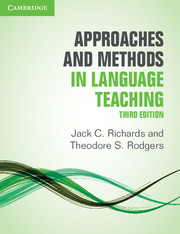Book contents
- Frontmatter
- Contents
- Acknowledgments
- Introduction to the third edition
- I Major trends in twentieth-century language teaching
- II Current approaches and methods
- III Alternative twentieth-century approaches and methods
- IV The teaching and learning environment
- Appendix: Comparison of approaches and methods
- Author index
- Subject index
22 - Postscript
Published online by Cambridge University Press: 08 April 2022
- Frontmatter
- Contents
- Acknowledgments
- Introduction to the third edition
- I Major trends in twentieth-century language teaching
- II Current approaches and methods
- III Alternative twentieth-century approaches and methods
- IV The teaching and learning environment
- Appendix: Comparison of approaches and methods
- Author index
- Subject index
Summary
From the survey of approaches and methods presented in this book, we have seen that the history of language teaching in the last one hundred years has been characterized by a search for more effective ways of teaching second or foreign languages. The most common solution to the “language teaching problem” was often seen to lie in the adoption of a new teaching approach or method. One result of this trend was the era of so-called designer or brand-name methods, that is, packaged solutions that can be described and marketed for use anywhere in the world. Thus, the Direct Method was enthusiastically embraced in the early part of the twentieth century as an improvement on Grammar Translation. In the 1950s the Audiolingual Method was thought to provide a way forward, incorporating the latest insights from the sciences of linguistics and psychology. As the Audiolingual Method began to fade in the 1970s, particularly in the United States, Communicative Language Teaching (CLT) as well as a variety of guru-led methods emerged to fill the vacuum created by the discrediting of Audiolingualism. While minor methods such as the Silent Way, Total Physical Response, and Suggestopedia had declined substantially by the turn of the century, new proposals for the organization of language teaching and learning have continued to influence language teaching policies and practices in different parts of the world. As noted in this text, these include Task-Based Language Teaching, Text-Based Instruction, CLIL, and the Common European Framework of Reference. And CLT continues to be considered the most plausible basis for language teaching in many contexts today, although, as we saw in Chapter 5, CLT can be applied and interpreted in a variety of ways. As Waters observes (2012), for some, CLT has taken the form of Task-Based Language Teaching (TBLT), for some, it is best reflected in a CLIL approach, while for others it is reflected in Dogme ELT, “a materials-light, conversation-driven philosophy of teaching that, above all, focuses on the learner and emergent language” (Meddings and Thornbury 2009: 103). Reviewing developments in approaches and methods since 1995, Waters (2012) concludes that at the level of classroom practice, since the 1990s methodology has been relatively stable.
- Type
- Chapter
- Information
- Approaches and Methods in Language Teaching , pp. 382 - 387Publisher: Cambridge University PressPrint publication year: 2014

